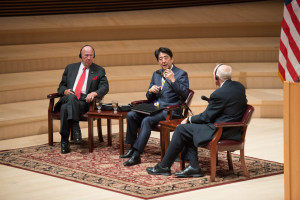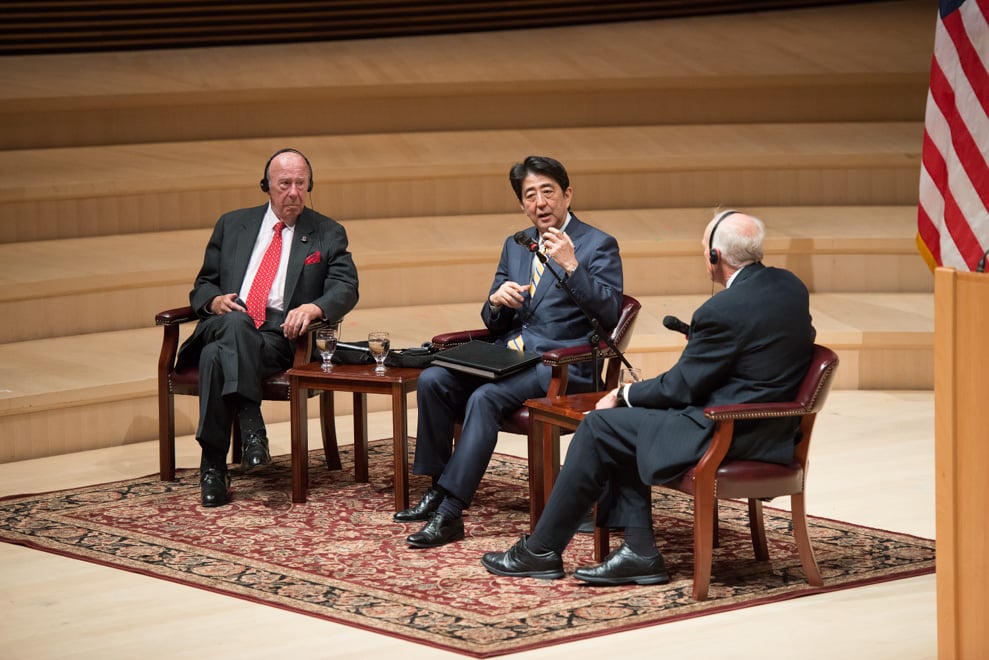
(Courtesy of Linda A. Cicero/Stanford News Service)
Japanese Prime Minister Shinzo Abe spoke about his innovation initiatives and ideas of promoting exchanges between Japan and Silicon Valley in a speech at Bing Concert Hall on Thursday afternoon. Meanwhile, dozens of demonstrators gathered outside the Hall, protesting his revisionist historical views and nationalist sentiments regarding Japan’s role in World War II.
The event, lasting for about 30 minutes, also featured Stanford President John Hennessy and former Secretary of State George Shultz. In his welcoming speech, Hennessy pointed out Stanford’s long-lasting connections with Japan, mentioning that as early as 1891, when the school was founded, a Japanese student was among Stanford’s first class.
Abe’s brief talk was entirely devoted to business innovation.
“Japan’s policy to ventures must be radically changed,” he said in Japanese, contrasting the social milieu of Japan with that of Silicon Valley. “In Japan, the current system of regulation has mainly aimed at protecting the welfare of Japanese citizens. This is a very strong philosophy.”
But Abe added that he thinks it is exactly because of this philosophy that “dynamism is lost,” and Japanese people are thus losing their jobs when facing international competition.
Elected as Prime Minister for the second time in 2012, Abe championed a series of economic reforms known as “Abenomics,” including bold monetary and fiscal policies, yet “protracted deflation, the flagging of consumer demand that has ensued, and the lowered saving rate due to an aging population are all worsening the macro balance of [Japan’s] economy,” Abe said earlier this week at Harvard’s Kennedy School of Government, according to an official transcript in Japanese.
“We want to learn from the culture of Silicon Valley,” Abe said.
In this context, he introduced the Kakehashi — meaning “bridge” in Japanese — Initiative, seeking to send top Japanese companies and accomplished researchers and businesspeople to Silicon Valley to strengthen collaboration between Japan’s high-tech industry and America’s technology enterprises. He said that he hopes that the initiative may “establish an atmosphere conducive to the development” of innovation and entrepreneurialism.
“Japan has closely studied the U.S.,” Abe said.
In regard to Stanford, Abe mentioned Japan Biodesign, a program of biomedical cooperation between Stanford and three Japanese universities. According to a fact sheet provided by University Communications after the event, the program will allow faculty from these schools to collaboratively “create new, interdisciplinary training structures and methodologies.”
Heading from Boston and Washington, D.C., to Silicon Valley, Abe sought to transition the focus of his state visit from politics to business; nevertheless, he has been confronted by protesters on both coasts concerned with the same issue — Abe’s views on World War II.
“We believe Prime Minister Shinzo Abe’s revisionist historical perspective is definitely wrong, and we stand for something right that should be acknowledged,” said Won Gi Jung ’18, one of the protesters, adding that the Japanese government should acknowledge and apologize for Japan’s practice of coerced sexual slavery during World War II.
Widely regarded as a nationalist figure, Abe has made a series of moves veering apparently toward a reinterpretation of Imperial Japan’s role in the war 70 years ago. In 2013, he visited the Yasukuni Shrine, a controversial memorial honoring, among others, convicted war criminals in World War II and is therefore regarded as a symbol for Japanese militarism by other East Asian countries, including China and Korea.
Abe has also been advocating for a more nationalistic view of Japanese history, having led the Japanese Society for History Textbook Reform, which authored a history textbook downplaying Japan’s war crimes.
This January, Abe accused an American textbook of misrepresenting history.
The textbook, used in some public schools in California, mentioned that Japan “forcibly recruited, conscripted and dragooned as many as 200,000 women ages 14 to 20 to serve in military brothels.” McGraw Hill, the publisher of the textbook, maintained the accuracy of the statement and refused to alter the description despite the request from Abe’s government.
“This kind of textbook is being used in the U.S., as we did not protest the things we should have, or we failed to correct the things we should have,” said Abe, quoted in a Japanese newspaper.
During a Q&A session at Harvard, Abe was directly confronted about his apparent historical revisionism concerning Japan’s enforced sex slaves in the Second World War.
“When it comes to the ‘comfort women’ issue,” said Abe, referring to the coerced sexual slavery, “my heart aches when I think about those people who were victimized by human trafficking and were subject to immeasurable pain and suffering,” according to a live interpretation quoted in The Harvard Crimson. He did not offer a direct apology despite the demand of protesters outside the lecture hall.
Before coming to Stanford, Abe addressed a joint Congressional meeting in Washington, D.C., yesterday, where Abe offered “with profound respect my eternal condolences to the souls of all American people that were lost during World War II.”
“History is harsh. What is done cannot be undone,” he said.
Instead, he underscored the value of liberal democracy shared by both the U.S. and post-war Japan and emphasized the significance of U.S.-Japanese economic and military alliance.
Abe’s father, Shintaro Abe, was Foreign Minister of Japan from 1982 to 1986, when Shultz served his American counterpart in the Reagan administration. The two diplomats have thus developed a personal friendship, which Shultz fondly recounted after Abe’s speech at Stanford. He also presented Abe with a picture of the two families as a gift. Abe then answered questions from Hennessy and Shultz. No public Q&A was offered.
Contact Tom Cao at qitong ‘at’ stanford.edu.
